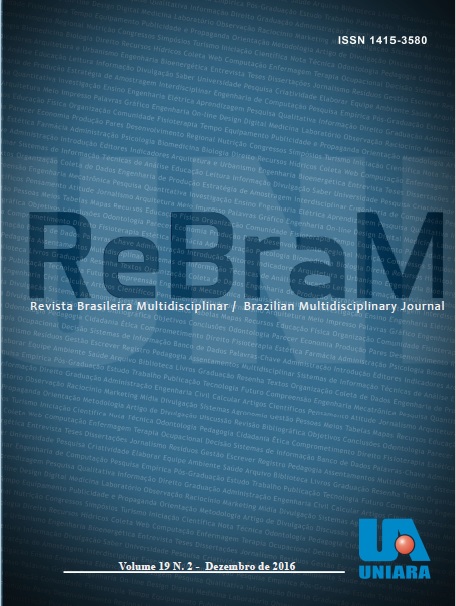SÍNDROME DO CHOQUE ACÚSTICO EM TRABALHADORES USUÁRIOS INTENSIVOS DE HEADSET E TELEFONE: UMA REVISÃO DE LITERATURA
Main Article Content
Abstract
Downloads
Article Details
• The author (s) warrant that the contribution is original and unpublished and that it is not in the process of being evaluated in other journal (s);
• The journal is not responsible for the opinions, ideas and concepts issued in the texts, as they are the sole responsibility of the author (s);
• Publishers have the right to make textual adjustments and to adapt the article to the rules of publication.
Authors retain the copyright and grant the journal the right of first publication, with the work simultaneously licensed under the Creative Commons Attribution License, which allows the sharing of work with acknowledgment of authorship and initial publication in this journal.
Authors are authorized to take additional contracts separately, for non-exclusive distribution of the version of the work published in this journal (eg publish in institutional repository or as book chapter), with acknowledgment of authorship and initial publication in this journal.
Authors are allowed and encouraged to publish and distribute their work online (eg in institutional repositories or on their personal page) at any point before or during the editorial process, as this can generate productive changes as well as increase the impact and citation of the published work (See The Effect of Free Access) at http://opcit.eprints.org/oacitation-biblio.html
References
AUSTRALIAN COMMUNICATION INDUSTRY FORUM - ACIF. Industry guideline. ACIF G616:2013 - Acoustic safety for telephone equipment, Incorporating Amendment n. 1, 2014.
AUSTRALIAN STANDARD / AUSTRALIAN COMMUNICATION INDUSTRY FORUM (AS/ACIF). AS/ACIF S004:2008 - Voice performance requirements for customer equipment. Disponível em: <http://www.commsalliance.com.au/__data/assets/pdf_file/0009/38961/S004_2008.pdf> Acesso em: 02 mar. 2016.
BRASIL. Agência Nacional de Telecomunicações – ANATEL. Resolução no 529, de 3 de junho de 2009. Regulamento para certificação de equipamentos de telecomunicações quanto aos aspectos de segurança elétrica. Brasília: Ministério das Telecomunicações. Disponível em: <http://www.anatel.gov.br/legislacao/resolucoes/2009/149-resolucao-529> Acesso em: 02 mar. 2016.
______. Decreto nº 3.048, de 6 de maio de 1999, que aprova o Regulamento da Previdência Social. Brasília: Ministério da Previdência e Assistência Social, 1999. Disponível em: <http://www.planalto.gov.br/ccivil_03/decreto/d3048.htm> Acesso em: 02 mar. 2016.
______. Ministério da Saúde do Brasil. Organização Pan-Americana da Saúde no Brasil. Doenças relacionadas ao trabalho: manual de procedimentos para os serviços de saúde. Brasília: Ministério da Saúde do Brasil, 2001. 580P. (Normas e Manuais Técnicas, n. 114).
______. Ministério do Trabalho e Emprego – MTE. NR 15 - Atividades e operações insalubres. Portaria MTb n.º 3.214, de 8 de junho de 1978. Brasília: Ministério do Trabalho e Emprego. Disponível em: <http://portal.mte.gov.br/data/files/8A7C816A47594D040147D14EAE840951/NR-15%20(atualizada%202014).pdf> Acesso em: 02 mar. 2016.
______. Portaria SIT N.º 09, 30 de março de 2007. Anexo II - Trabalho em teleatendimento/telemarketing da NR 17 – Ergonomia. Brasília: Ministério do Trabalho e Emprego. Disponível em: <http://portal.mte.gov.br/data/files/ff8080812be914e6012befbdacd94b74/nr_17_anexo2.pdf.> Acesso em: 02 mar. 2016.
DILLON, Harvey. Acoustic shock outlined. National Acoustics Laboratories (NAL), 2010.
GROOTHOFF, B. Acoustic shock in call centres. Australian Acoustical Society, p.335-340, nov. 2005.
HEALTH AND SAFETY EXECUTIVE - HSE. Acoustic shock, 2008. Disponível em: <http://www.hse.gov.uk/noise/acoustic.htm> Acesso em: 02 mar. 2016.
HOOPER, RE. Acoustic shock controversies. The Journal of Laryngology & Otology, v.128, Suppl. 2, p.S2–9, jul. 2014.
JABRA®. A reference guide to acoustic terminology. Disponível em: <http://www.suprag.ch/fr/DBFiles/29_WhitePaper_Laermschutz_fr.pdf> Acesso em: 12 abr. 2016.
McFERRAN, Don. Acoustic shock. Canadian Academy of Audiology, v.3, n.2, p.1, 2016.
MILHINCH, Jewellers. Acoustic shock injury: a report on injury following acoustic incidents in call centres. New Zealand Medical Journal, v. 123, n.1311, p.31-167, 2010.
NAGERIS, Ben I.; ATTIAS, Joseph; SHEMESH, Rafi. Otologic and audiologic lesions due to blast injury. Journal of Basic & Clinical Physiology & Pharmacology, v.19, n.3-4, p.185-191, 2008.
PARKER, William; PARKER, Victoria; PARKER, Glynn; PARKER, Andrew. Acoustic shock: a new occupational disease? Observations from clinical and medico-legal practice. International Journal of Audiology, v.53, n.10, p.764–769, out. 2014.
POLARIS COMMUNICATIONS Pty Ltd. Contact centre acoustic safety & comfort: An employer’s responsibility, an employee’s prerogative. 2011. Disponível em: <https://www.polaris.com.au/media/1077/contact-centre-acoustic-safety-comfort.pdf> Acesso em: 02 mar. 2016.
______. The definitive guide to acoustic safety & comfort in contact centres & offices. 2014. Disponível em: <https://www.polaris.com.au/media/1106/the-definitive-guide-to-acoustic-safety.pdf> Acesso em: 02 mar. 2016.
VEERANNA, N.; VINODH, R.S. Evaluation of acoustic shock induced early hearing loss with audiometer and distortion product otoacoustic emissions. Indian Journal of Medical Sciences, v.64, n.3, p.132-139, mar. 2010.
WESTCOTT, Myriam. A perspective on tinnitus, hyperacusis and acoustic shock research. ENT News, v.17, p.94-98. 2008.
______. Acoustic Shock Disorder (ASD) and Tonic Tensor Tympani Syndrome (TTTS). Guide for Medical Practitioners. 2006b
______. Acoustic shock disorder: tinnitus discovery. New Zealand Medical Journal, v.123, p.25–31, 2010.
WESTCOTT, Myriam. Acoustic shock injury (ASI). Acta Oto-Laryngologica, n.556, p.54-58, dez. 2006a.
______. Assessment and management of acoustic shock, tonic tensor tympani syndrome (TTTS), hyperacusis and misophonia. In: 8th International Tri Tinnitus Conference; 2014 Mar; Auckland. Proceedings. Auckland: TRI; 2014.





